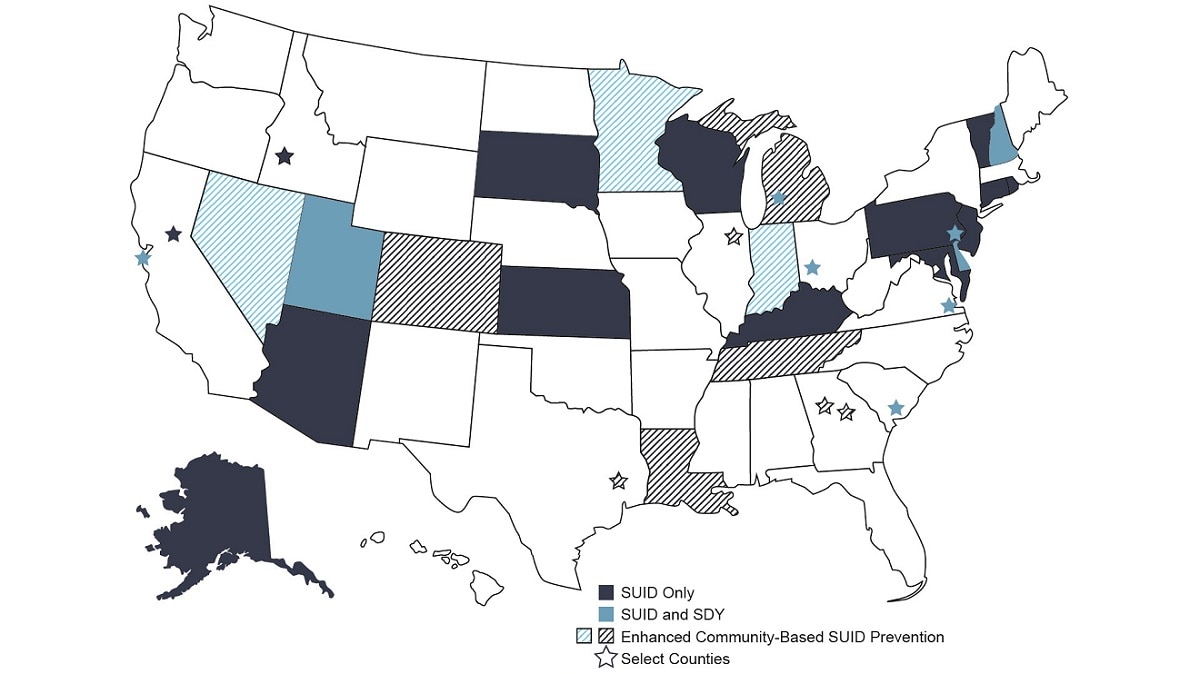SUID and SDY Case Registry
As part of the Sudden Unexpected Infant Death (SUID) and Sudden Death in the Young (SDY) Case Registry, CDC’s Division of Reproductive Health supports SUID monitoring programs in 32 sites, covering about 2 in 5 SUID in the United States. The SUID and SDY Case Registry builds on child death review programs and uses the National Center for Fatality Review and Prevention’s Case Reporting System, bringing together information about the circumstances associated with SUID and SDY, as well as Health information about investigations into these deaths. Participating sites use data about SUID and SDY trends and circumstances to develop strategies to reduce future deaths.
CDC and the National Institutes of Health collaborate on SDY monitoring, which expands the SUID Case Registry to include children and adolescents in 12 sites. The SDY component of the Case Registry was created to increase the understanding of the prevalence, causes, and risk factors for infants, children, and adolescents who die suddenly and unexpectedly and to inform strategies to prevent future deaths.
In addition, 10 participating sites were also funded to implement enhanced community-based SUID prevention activities using SUID and SDY Case Registry data and evidence-based recommendations from the American Academy of Pediatrics.
SUID and SDY Case Registry Activities
Participating sites conduct the some or all of following activities:
- Monitor SUID and SDY trends and characteristics that may affect the risk of SUID, such as infant sleep position. Monitoring SUID and SDY rates is vital to identifying new risk factors and tracking progress toward reducing SUID and SDY.
- Improve the quality and consistency of SUID and SDY investigation data. This activity helps standardize the process of determining cause of death. As a result, sites are able to more accurately monitor SUID and SDY rates and develop informed prevention activities.
- Use data about SUID and SDY trends and characteristics to carry out actions to reduce future deaths. Examples of these activities include:
- Educating parents and caregivers about safe sleep for babies.
- Training hospital staff on safe sleep recommendations.
- Supporting policy changes that require childcare centers to apply safe sleep recommendations.
- Implement enhanced community-based SUID prevention activities that address specific community needs, including:
- Developing community participatory data-driven planning to address challenges to the implementation of safe sleep practices.
- Working with these communities to implement prevention strategies to reduce sleep-related infant deaths.

SUID Only
Participating sites include Alaska; Arizona; Sacramento County, California: Connecticut; Dekalb and Fulton County, Georgia; Canyon County, Idaho; Cook County, Illinois; Kansas; Kentucky; Louisiana; Maryland; New Jersey; Pennsylvania; Rhode Island; South Dakota; Tennessee; Harris County, Texas; Washington; Vermont; and Wisconsin.
SUID and SDY
Participating sites include San Francisco County, California; Delaware; Indiana; select counties in Michigan; Minnesota; Nevada; New Hampshire; Hamilton County; Ohio; Philadelphia County, Pennsylvania; select counties in South Carolina; Utah; and select counties in Virgina.
Enhanced Community-Based SUID Prevention
Participating sites include Colorado; Dekalb and Fulton County, Georgia; Cook County, Illinois; Indiana; Louisiana; Michigan; Minnesota; Nevada; Tennessee; and Harris County, Texas.
- AlaskaSuccess: After taking steps to improve cultural diversity in infant mortality reviews, the Alaska Maternal Child Death Review Program observed increased depth of discussion during reviews and more specific prevention recommendations.
- ColoradoSuccess: Colorado linked immunization and SUID data, allowing for more informed health promotion activities.
- KentuckySuccess: After a partnership with a home visiting program, almost 9 in 10 caregivers reported always placing their baby in a safe sleep area.
- TennesseeSuccess: After collaborating with programs to reach families in their homes, sleep-related infant deaths declined in Tennessee.